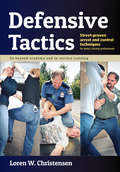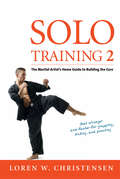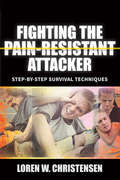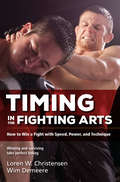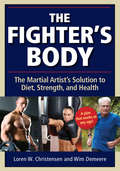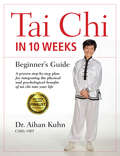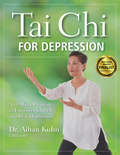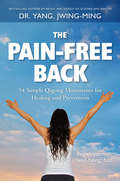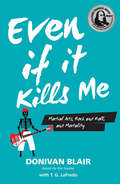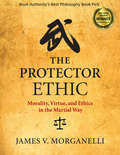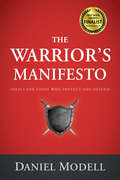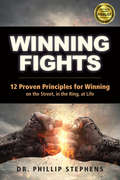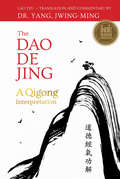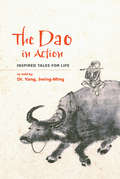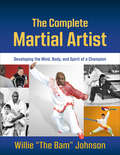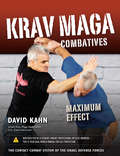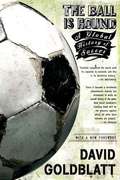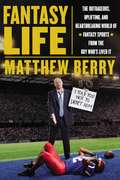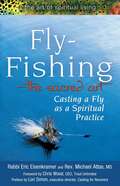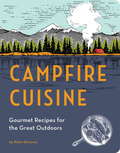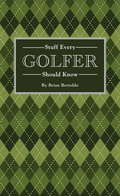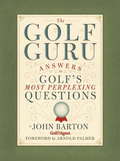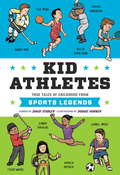- Table View
- List View
Defensive Tactics: Street-Proven Arrest and Control Techniques
by Loren W. ChristensenDefensive Tactics: Street Proven Arrest and Control Techniques Whether you are a law enforcement officer seeking to improve your edge or a martial artist wanting to expand your knowledge of street-proven techniques, you will find Defensive Tactics: Street-Proven Arrest and Control Techniques is filled with invaluable information to prepare you for even the most difficult scenarios.Highlights include* Joint manipulation that works* Leverage control vs. pain control* Striking with the hands, feet, forearms, and elbows* Safely and quickly crossing the gap* Blocking an assailant's strikes* Using vulnerable points to gain compliance* Head disorientation* Safe application of carotid constriction or "sleeper" holds* Controlling a suspect on the ground* Arresting big guys* Fighting concepts to take on patrol* Weapon retention in close quarters and on the ground Loren W. Christensen is a retired cop and high-ranking martial artist who survived everything the mean streets threw at him, working patrol, gang enforcement, and dignitary protection. Defensive Tactics goes beyond what is taught in the academy, during an officer's in-service training, and what is allowed by the administration.This book also includes a chapter on proven ways to control a suspect on the ground, written by LAPD officer Mark Mireles, an MMA coach, police academy trainer, and champion wrestler.
Solo Training: The Martial Artist's Home Training Guide
by Loren W. ChristensenTake your martial arts workout to the next levelLoren W. Christensen shows you over 300 ways you can add variety to your daily martial arts training routine. Whether you're a student looking for fun new solo drills to spice up your home training or an instructor in search of new ways to pump up your classes, this book has what you need. It is an incredible collection of drills, techniques, and exercises that will take your workouts to the next level.* Organize your solo workouts to get maximum results from even the shortest training sessions.* Improve your speed and power with dozens of inside tips and tricks.* Beat boredom and get excited about your solo training sessions.* Become a well-rounded fighter by adding essential skills your instructor may not be teaching you.* Safely experiment with new techniques to find your ideal personal style of training.* Get an edge on your opponents with training methods that will elevate your skills in the ring and on the street.Not only will you learn enough new training strategies and methods to keep you busy for years, but Loren W. Christensen's no-nonsense writing style will get you up and moving, even on the days you'd rather skip your solo workout. This book is packed with insight, technique, and motivation. It will become your favorite training partner.
Solo Training 2: The Martial Artist's Guide to Building the Core
by Loren W. ChristensenThe next evolution in fighting techniques and conceptsIn this follow-up to his phenomenally popular Solo Training, Loren W. Christensen digs down deep to come up with hundreds of more ways for you to rev up your training at home or in the gym. Solo Training 2 kicks off with a focus on building your body's core for stronger, faster, and more effective grappling, kicking, and punching. A strong core--chest, abs, hips, shoulders, and back--is the source of your body's power, speed, and coordinated movement. As a martial artist, having a strong core helps you to get more out of your training and to respond instantly and effectively to the fast-changing demands of competition or an explosive street encounter.You'll also get over 100 ways to work your combinations, cheat speed, improve accuracy, fight from unconventional stances, practice grappling when you can't find a partner, and get the most out of your mannequin bag.This book wraps up with eight workouts, each with a specific goal, like the free-hand power builder and the boxer workout.If you're looking to get more out of training, Solo Training 2 represents your next evolution in fighting techniques and concepts.
Fighting The Pain Resistant Attacker: Step-by-Step Survival Techniques
by Loren W. ChristensenStep-by-step survival techniquesThere is a truth in the world of hand-to-hand combat that too many martial artists aren't aware of or refuse to believe. Every time you discover a sure technique, one that makes all your training partners groan and writhe in agony, there exists out there in the mean streets a host of people who won't feel it. People like these:* Attackers with large muscle bulk or large fat bulk* Attackers intoxicated on alcohol* Attackers under the influence of drugs* Attackers out of control with rage* Attackers who are mentally deranged* Attackers who feel pain but like itLoren W. Christensen draws on decades of martial arts training and law enforcement experience, giving you techniques to survive the worst-case scenario.This book isn't about working out with a training partner. It's about surviving a desperate street attack against a nightmare adversary who doesn't acknowledge what you thought was your best shot.
Timing in the Fighting Arts: How to Win a Fight with Speed, Power, and Technique
by Loren W. Christensen Wim DemeereGet Every Last Ounce of Speed and Power Out of Your TechniquesWhat if there were a secret ingredient that could make every one of your martial arts techniques better? Not only faster and more powerful, but more likely to slam home to exactly the right target every time? Maybe there is.Timing is the art and science of ending a confrontation as quickly and efficiently as possible. In Timing for the Fighting Arts, authors Loren W. Christensen and Wim Demeere team up to teach you exactly how to get every last ounce of speed and power out of your techniques.Whether you want to feel safer on the street or emerge from the ring victorious, this book is packed with inside information essential to defeating your opponent.* Why many experts say timing is more important than speed* How to put the OODA loop and Hick's law to work for you* Why timing is both an offensive and a defensive asset* Which types of verbal distraction can give you an edge* Why controlling your opponent's spine gives you an advantage* Which tournament techniques really work on the street* How to set up multiple opponents to create timing opportunities* Which tricks law enforcement officers rely on to buy time* How you can improve your odds against a gun or knifeYou will find drills and practice scenarios to help you develop every one of these concepts. Go beyond theory and put your new knowledge to work in the ring or on the street, where you need it most.
Fighter's Body: The Martial Artist's Solution to Diet, Strength, and Health
by Loren W. Christensen Wim DemeereYou have an owner's manual for your car, your stereo, and even your blender, so why not your body? The Fighter's Body is exactly that--an owner's manual for your most complex piece of equipment.As a martial artist, you make special demands of your body. Have you ever wondered how that latest fad diet might affect your performance on the mat? Ever wanted to take off a few extra pounds? How about putting on muscle without slowing down? Making weight for a tournament? Losing five pounds fast? Eating better? Changing weight classes? Are you confused about supplements, vitamins, and protein shakes? Don't know where to start? Start here.This book will answer your questions about important topics including* Why some diets are harmful for martial artists * How to calculate your protein needs for training* When and how to use supplements* How to eat at fast food places and not ruin your diet* Why it's OK to splurge on "dirt day"* How to safely make weight for a tournament* Why HIIT training is essential to weight loss* What to eat on competition days* How to create a plan that works and stick to itLoren W. Christensen and personal trainer Wim Demeere combine their knowledge of martial arts, weight training, nutrition, diet, and exercise to answer your questions and put you on the road to becoming the best martial arts athlete you can be.
Tai Chi In 10 Weeks: A Beginner's Guide
by Aihan KuhnThis book is designed to guide beginning students through the fundamentals of tai chi in ten weeks. Dr. Aihan Kuhn teaches readers the twenty-four-step Yang-style form. She shares insight on warming up, healing, and avoiding injury. But tai chi is more than just a physical exercise. It is a way of life. Dr. Kuhn shows readers how this art helps us cultivate health, balance, and qi (energy). Each day millions of people around the world practice tai chi for wellness, focus, and self-defense. This is a lifelong path. For the novice, that idea can be exciting but also daunting. With all the books, videos, and websites on tai chi, where do you begin? Tai Chi in 10 Weeks is the answer. Dr. Aihan Kuhn is a master instructor of tai chi and qigong. In this book she shares the lessons she’s learned in a lifetime of studying and teaching. She is warm and encouraging, making readers of all ages and backgrounds feel welcome. This book features • A ten-week calendar to guide you through your introduction to tai chi • Over 200 beautiful full-color photos • Warm, welcoming instruction from a master of tai chi and qigong With this book you will • Learn the twenty-four-step Yang-style form • Understand the fundamentals of tai chi • Discover not just the physical postures of tai chi, but also its psychological, emotional, and spiritual benefits “Tai chi is a life journey,” Dr. Kuhn writes. Tai Chi in 10 Weeks is your map.
Tai Chi for Depression: A 10-Week Program to Empower Yourself and Beat Depression
by Aihan KuhnThis book is designed to help readers understand depression and make positive changes to overcome it. Dr. Aihan Kuhn teaches a unique tai chi form that combines elements of Chen and Yang styles as well as qigong and meditation. The form is easy to learn, easy to remember, and easy to practice. Dr. Kuhn’s multidisciplinary approach to mental health also focuses on positive thought, a healthy diet, and self-confidence. Dr. Kuhn instructs readers on a unique tai chi form that is perfect for beginners and experienced practitioners alike. The circular movements create better energy flow in the body. The martial character empowers the mind, strengthens the body, improves stamina, and increases self-esteem. Slow, symmetrical movements promote balance and calm. This book features: • Detailed instructions and photos describing Dr. Kuhn’s 16-step tai chi form • Personal reflections on using tai chi to overcome depression • A 10-week plan to help readers begin their journey to wellness With this book you will: • Learn about the clinical features of depression • Learn Dr. Kuhn’s 16-step tai chi form • Discover the psychological, emotional, and spiritual benefits of tai chi • Begin a holistic approach to mental health “When I was just starting out as a doctor, my focus was mainly on treating disease,” Dr. Kuhn writes. “Now my focus is on teaching people how to prevent disease and treating patients in the early stages of their illness so they can avoid additional problems.” In many ways, Tai Chi for Depression represents the culmination of her life’s work.
The Pain-Free Back: Gentle Qigong Movements for Healing and Prevention (Qigong Healing Ser.)
by Jwing-Ming YangThe spine is the root of all motion, and a helthy back is vital to well-being.According to the National Institute of Neurological Disorders and Stroke, nearly 80 percent of adults experience low back pain at some point in their lives. For many, the condition progresses to the point where they will have to manage pain for years to come. Some will have little choice but to rely on prescription medication. But for the millions of others with back pain, there is hope. By committing to a series of simple exercises, we can remain loose and flexible. We can prevent and heal injuries to maintain a strong, healthy back. Motion is the key, and in this book Dr. Yang, Jwing-Ming will get you moving. You will regain natural, pain-free motion and balance with qigong, a timeless Chinese art that promotes healing, flexibility, and balance. The gentle, meditative movements emphasize proper motion in coordination with breath, making qigong the right choice for preventing, treating, and healing back pain. This book presents 54 gentle qigong movements to help you loosen, stretch, strengthen, heal and maintain a strong back for a lifetime. You will learn • What qigong is and why it is a good choice for healing and maintaining a healthy back • 3 back-loosening movements • 12 back-stretching movements • 30 back-healing movements • 7 movements for immediate relief • 2 back-strengthening movements • A 12-step plan for keeping your back healthy. Many people rely on acupuncture, chiropractic treatments, and even surgery. By committing to a simple qigong practice, you can begin to take care of your own back, with less reliance on others. Pain-free motion is the goal, and qigong movements will help you accomplish that goal.
Even If it Kills Me: Martial Arts, Rock, and Roll, and Mortality
by Donovan BlairBenjamin Franklin Award SILVER WINNER - 2017 This is the true story of a rock and roll musician who takes up taekwondo at forty-one years old. Doni Blair, bassist for the Toadies, knows he’s past his physical prime, but he’s determined to push himself and pursue his dream of becoming a martial artist—even if it kills him. As a kid Doni was obsessed with ninjas and kung fu movies. He and his brother took up taekwondo—there was no ninja school in Sherman, Texas. Classes were expensive, especially considering their parents’ tenuous employment status and fondness for alcohol. The family lived like “white-trash gypsies,” Blair writes, adding that he got good at moving furniture at three in the morning. The Blair kids loved taekwondo, but the family just couldn’t afford classes. Doni walked away from martial arts. Thirty years later, he’s walking back. “I’m not a kid anymore,” he writes. “I’m a middle-aged man trying to come to grips with being a middle-aged man. I’m not as fast as I used to be. It takes longer for the injuries to heal. I have to eat more bran.” Doni discovers the road to black belt is rough and, well, weird. He meets martial seekers of every sort. He has run-ins with a teenage savant who seems determined to break the author’s leg. He drives a van full of seven-year-olds for the dojang’s after-school program. They puke everywhere. Even If It Kills Me is smart and funny, introspective and irreverent. It blends rock and roll and taekwondo—two of the coolest things in the world.
The Protector Ethic: Morality, Virtue, and Ethics in the Martial Way
by James V. MorganelliDiscover how the martial way leads to a protector ethic The Protector Ethic is a deep dive exploring the principles and values that must anchor a modern warrior. The author is compelling, insightful, and not afraid of controversy. As the book begins, we are thrust into the true story of a robbery turned homicide. It happens midday on a train. The victim is twenty-four, and the murderer is eighteen. What unfolds is nothing short of horrific, yet the other passengers refuse to help. James V. Morganelli sees this as a symptom. When we are reluctant to defend ourselves, when we refuse to protect those around us, we become part of the disease. As a martial artist and ethicist, the author says martial arts are much more than technical exercises. They offer us a “physical philosophy”—one that allows us to understand ourselves, teaches us about others, and demonstrates the true meaning of justice. They help us make difficult moral decisions. Ultimately, isn’t this why we train? Readers will • Understand natural law, protective instinct, and self-risk. • Examine the martial way of valuing, reasoning, judging, and acting. • Discover how moral relativism, political correctness, and contrived social-justice campaigns do not make people equal. They can actually dehumanize us. • Recognize what it means to be an ethical warrior. Only the great books address philosophy for the contemporary warrior, which is why such titles as Zen in the Martial Arts, Living the Martial Way, and Meditations on Violence have become modern classics. The Protector Ethic is an indispensable contribution to this conversation. “Are you seeking ancient martial secrets?” Morganelli writes. “Here’s one. You already know how to defend yourself. A qualified instructor can run you through the basics, but that should take about ten minutes. After that, the serious work begins.” The martial way only lives when we treat it as something that can die.
The Warrior's Manifesto: Ideals for Those Who Protect and Defend
by Daniel ModellThe Warrior’s Manifesto is a concise and potent declaration of principles that outline what it means to be a warrior. It is a brief, dramatic statement on the what, the why, and the way. These are not mere abstractions. Warriors must understand and embody them to bring wisdom, courage, and clarity to their work. Daniel Modell knows the importance of this grounding. He served twenty years with the New York Police Department before retiring as a lieutenant. “A warrior is not defined by insignia, uniforms, or shields; a warrior is not birthed by bow, sword, or gun,” he writes. “Warriors existed before all these things, and where he dons or wields them bestows them their meaning.” From ancient times to our own era, the way of the warrior has been a path apart. Whether serving in the trenches or securing our streets, warriors embrace a life most citizens would never choose. As Modell writes, the pay is modest, the hours long and ungodly. Warriors find themselves away from their families, often in harm’s way. They experience horror and tragedy. Politicians exploit them. The media and the public scrutinize their every act. “You will begin each day knowing that you may never see another,” Modell says. He makes it clear that this is no mere job. It is a calling. “You must stand between the predators and the innocents of the world and hold the line with your blood,” he writes. The Warrior’s Manifesto is an undeniable statement that will influence warriors for generations. This book is certain to become a classic.
Winning Fights: 12 Proven Principles for Winning on the Street, in the Ring, at Life
by Dr Phillip StephensWinning Fights focuses on 2,500 years of proven fighting principles originating from Eastern concepts and proceeding to the modern era. This book is for pugilists seeking an edge in competition as well as soldiers and law enforcement officers facing conflict. Like The Art of War and The Book of Five Rings, however, many of its lessons also apply to the world of business and negotiation. The majority of martial art books are dedicated to technique. They feature photos and descriptions of strikes, blocks, evasions, and submissions. While many of these titles are important and influential, it is clear that if our martial study is simply about acquiring new tactics, we risk leaving a void in our training—and possibly in our own character. Dr. Phillip Stephens conducted extensive research in developing this work. He drew from his years of martial training and his experience as a member of the North Carolina Boxing Commission. He even reached out to combat personnel at Fort Bragg, North Carolina, who offered additional insight on what it takes to prepare for combat—and to prevail. Dr. Stephens looked beyond the technical to the conceptual and found that winning fights requires twelve core principles: preparation, awareness, commitment, lethality, efficiency, discipline, power, focus, fierceness, surprise, timing, and fortitude. This book features • Twelve principles for winning fights • A survey of Eastern and Western traditions • An intelligent yet accessible discussion of these concepts With this book you will • Learn to see beyond fighting tactics, which change, to fighting principles, which endure • See your training in powerful new ways “Winning fights is based on principles, not techniques,” Dr. Stephens writes. “Technique is important, but techniques change, adapt, and evolve. Principles are timeless.”
The Dao De Jing: A Qigong Interpretation
by Jwing-Ming Yang Lao TzuThis book examines one of the world’s most enduring and influential literary works, the Dao De Jing, through the timeless art of qigong. In his words, Lao Tzu (or Laozi), author of the Dao De Jing, embodies qigong principles, advocating the cultivation of mind and body. Only when we know qigong can we know Lao Tzu —and only when we know Lao Tzu can we know the Dao De Jing. Dr. Yang, Jwing-Ming, a renowned author, scholar, and martial artist, devoted decades to researching and writing this book. He interprets and analyzes the 81 chapters of the Dao De Jing. His commentary will bring new insight, inspiration, and depth to your understanding of Lao Tzu’s words—and to your qigong practice. “Many chapters in the Dao De Jing purely talk about qigong,” Dr. Yang writes, “especially the practices of regulating the body, breathing, mind, qi, and spirit.” Lao Tzu’s writing has been read, translated, and discussed around the globe. It deals with principles that transcend time and culture. That is why this ancient text has been reimagined countless times in books on business, relationships, and parenting—but never with a focus on the art of qigong. This makes Dao De Jing: A Qigong Interpretation unique and indispensible. This book includes • The complete Dao De Jing in English and its original Chinese text • Dr. Yang, Jwing-Ming’s commentary and analysis of each chapter • Numerous illustrations and diagrams Dao De Jing: A Qigong Interpretation is not a book of instruction. It is about the Way—the path before us, in qigong and in life, where what you achieve comes through your own understanding.
The Judo Advantage: Controlling Movement with Modern Kineseology (Martial Science Ser.)
by Steve ScottA modern biomechanical perspective of traditional judo This book explains the principles behind judo and other grappling sports. As a judo expert and veteran coach, Steve Scott merges traditional martial wisdom with modern kinesiology, the study of human anatomy and movement. This new biomechanical perspective helps competitors develop every facet of their grappling skill, giving them a clear advantage in controlling opponents. Athletes involved in martial arts that incorporate grappling and throwing will discover the keys to greater balance, power, and speed. The Judo Advantage explores the dynamics of how and why the human body works most efficiently for throwing, submission, and pinning techniques. Although judo provides the basis for the author’s analysis, his insights also relate to other grappling sports such as Russian sambo, Brazilian jiu-jitsu, and Olympic and collegiate wrestling. Gain a competitive edge using the principles of human biomechanics. Master the ability to control your opponent’s movements. Improve fluency for seamless transition between techniques. Generate incredible power and speed. This book features In-depth analysis of stances, balance breaking, throws, takedowns, transitions, ground fighting, trapping, footwork, combinations, gripping, posting, linear and angular movement, torque, generating power, evading, generating force, changing directions, and stability. Over 200 action photos. Drills and winning insight for coaches and athletes of grappling arts. “This book explains how and why judo works and why the principles of Professor Jigoro Kano, judo’s founder, have stood the test of time,” Scott says. Steve Scott breaks down all aspects of judo in this insightful and accessible work. It will help grapplers reach the next level in their sport.
The Dao in Action: Inspired Tales for Life
by Jwing-Ming YangIn this collection of fables, Dr. Yang, Jwing-Ming shares the stories that have influenced him most as a martial artist and lifelong student of the Dao. They bring the Dao to life for readers of all generations. Whoever we are, wherever we’re going, these short tales help us along the path—the Way. Some offer the traveler a moral compass. Some illustrate the dangers in human folly. Others just make us laugh. The Dao in Action will inspire young readers to refine their character. Older readers will smile and recognize moments of truth. This collection is for anyone who would like to explore the enduring lessons of martial wisdom. Fables entertain us, enlighten us, and guide us. We recognize ourselves in the characters, be they emperors, village girls, or singing frogs. They help us see our own weaknesses, strengths, and possibilities. Their lessons transcend time and culture, touching what it really means to be alive. For example, in life we must ask questions, learn from others, and find our place in the world. On the other hand, there is real danger in worrying too much about what others think. This lesson is clear—and very humorous—in the story “A Donkey, a Father, and a Son.” We must help others and give of ourselves, but we must also guard against those who would take advantage of us, as in “The Wolf, the Scholar, and the Old Man.” We should save our money and plan for the future, but we must also resist greed, lest we end up “A Rich Man in Jail.” These lean, concise fables illustrate that balance, the duality of yin and yang, always shifting, always in correction. They help us laugh at our human predicaments—and maybe even at ourselves.
Complete Martial Artist: Developing the Mind, Body, and Spirit of a Champion
by Willie Johnson“Chronically unsatisfied and feeling like we are always behind in this mission we call life.” In today’s fast paced world, young adults and twenty-something’s are subject to chronic fears of missing out, mental health issues, anxiety, and depression unlike any generation that has come before. The martial arts have the potential to help. Traditional martial arts revolve around principles and core values such as honor, integrity, perseverance, patience, humility, and respect. Manifesting in self-expression and creativity to promote individual growth and a balanced approach to living. A complete martial artist learns how to conquer “self” through the rigors of martial arts training and how to live by these traditional core values. Although there are occasions when martial arts may be used for self-defense, its primary uses are for sport, and character and spiritual fulfillment. This book, The Complete Martial Artist, offers young adults and twenty-something’s an opportunity to see what martial arts can do for their lives. The author shares His own childhood story of hardship and redemptionHow to adopt martial arts values as a way of livingImportant universal principles to live byOn creating a championship attitudeExamples about martial arts forms (kata) and sparringHow to get started and be successful in your personal martial arts journey If you are a young adult (or parent of one), or in your twenties and in search of the answers to life’s questions, The Complete Martial Artist can be a key unlocking a door to your own self-development toward a balanced approach to living.
Krav Maga Combatives: Maximum Effect
by David KahnBECAUSE NOT ALL KRAV MAGA IS THE SAME® This book is designed for krav maga trainees, security-conscious civilians, law enforcement officers, security professionals, and military personnel alike who wish to refine their essential krav maga combatives, improve their chances of surviving a hostile attack and prevail without serious injury. Combatives are the foundation of krav maga counter-attacks. These are the combatives of the original Israeli Krav Maga Association (Grandmaster Gidon). It is irrefutable that you need only learn a few core combatives to be an effective fighter. Simple is easy. Easy is effective. Effective is what is required to end a violent encounter quickly, decisively, and on your terms. This book stresses doing the right things and doing them in the right way. Right technique + Correct execution = Maximum Effect. Contents include Key strategies for achieving maximum combative effects Krav maga’s 12 most effective combatives Developing power and balance Combatives for the upper and lower body Combative combinations and retzev (continuous combat motion) Combatives for takedowns and throws Combatives for armbars, leglocks, and chokes Whatever your martial arts or defensive tactics background or if you have no self-defense background at all, this book can add defensive combatives and combinations to your defensive repertoire. Our aim is to build a strong self-defense foundation through the ability to optimally counter-attack.
The Ball Is Round: A Global History of Soccer
by David GoldblattAt nearly 1000 pages, this global history of the sport of soccer is determined to be as comprehensive as possible. Goldblatt, an English writer who has previously published "World Football Yearbook", traces the history of soccer from its ritualistic past into its current incarnation as an international phenomenon. Combining statistics and development of this sport with dozens of witty anecdotes, this book should interest anyone who has ever kicked a black-and-white ball into a net.
Fantasy Life: The Outrageous, Uplifting, and Heartbreaking World of Fantasy Sports from the Guy Who's Lived It
by Matthew BerryAn inside look at the world of fantasy sports from America's most trusted name in the industry. Berry explores the increasingly ubiquitious world of fantasy sports. Every year, millions of people spend their time assembling, managing and obsessing over fantasy teams.
Fly Fishing - The Sacred Art: Casting a Fly as Spiritual Practice (The Art of Spiritual Living)
by Chris Wood Eric Eisenkramer Micheal Attas Lori SimonDiscover the spiritual potential hidden in every cast of the fly rod. <p><p>"For us, fly-fishing is about more than catching fish. We have been skunked on the stream too many times to count, and stood shivering in our waders in 45-degree water long after sundown. Yet, every chance we get, we head back to the river in search of trout and something more." ―from Rabbi Eric's Introduction <p><p>"Early in my fly-fishing career I remember telling a friend that there is so much to learn! Some forty years later, that is still true. Every trip I learn something new about rivers, fish and the natural world. Most importantly, I learn something new about myself. Every encounter with the waters of our planet draws me deeper into who I am and who I want to become." ―from Reverend Mike's Introduction <p><p>In this unique exploration of fly-fishing as a spiritual practice, an Episcopal priest and a rabbi share what fly-fishing has to teach us about reflection, awe and the wonder of the natural world, the benefits of solitude, the blessing of community and the search for the Divine. Tapping the wisdom in the Christian and Jewish traditions and their own geographically diverse experiences on the water, they show how time spent on the stream can help you navigate the currents and eddies of your own inner journey.
Campfire Cuisine
by Robin DonovanFinally, here's a guide for people who love good food and the great outdoors. Campfire Cuisine provides more than 100 recipes for delicious, healthy, satisfying meals to make at your campsite or in any outdoor setting. Also included are tips on meal planning, shopping, and choosing the right equipment. Armed with Campfire Cuisine everyone from die-hard foodies to novice cooks will be ready to take on eating well while camping out.
Stuff Every Golfer Should Know
by Brian BertoldoThis little book teaches everything you'll need to get your golf lifestyle up to par.Discover:* How to Calculate Your Handicap* How to Play in the Rain* How to Keep Fit for Golfing* Games to Play within the Game* The Best Golf Travel DestinationsPlus tricks for reading the green, tips for playing in the wind, a guide to course etiquette, advice on golfing with kids, and much more!
The Golf Guru
by John Barton Arnold PalmerWhy do golfers yell "fore"? Is it ever acceptable for a man to use a purple golf ball? If my boss invites me to play golf, should I let him win? Since 2002, readers of Golf Digest have submitted their most puzzling and perplexing golf questions to the Golf Guru, a.k.a. John Barton, whose monthly column answers these imponderables with authority and good humor. This illustrated golfer's miscellany compiles more than 250 of his most compelling Q&As, tackling everything from history and physics to fashion, etiquette, and beyond. Why do golf courses have 18 holes? How much is a membership at Augusta National? Is golf really an acronym for "Gentlemen Only, Ladies Forbidden"? Whatever the question, the Golf Guru has the answer!
Kid Athletes
by Doogie Horner David StablerThe author and illustrator of Kid Presidents have reteamed to share 20 true tales from the childhoods of famous athletes. From Babe Ruth (so incorrigible that his parents put him in reform school at age 7) to Muhammad Ali (who learned to fight at age 12 after a thief stole his bicycle), Kid Athletes is packed with inspirational stories from the world of sports. Billie Jean King rose from modest circumstances to win 39 Grand Slam championships; race car champion Danica Patrick fended of bullies who told her "girls can't drive"; and martial arts legend Bruce Lee credited his success, in part, to childhood dance lessons. Every goal, touchdown, and championship comes to life in these kid-friendly and relatable stories, all with Doogie Horner's whimsical full-color illustrations. Kid Athletes is a slam dunk for young sports fans everywhere.From the Hardcover edition.
